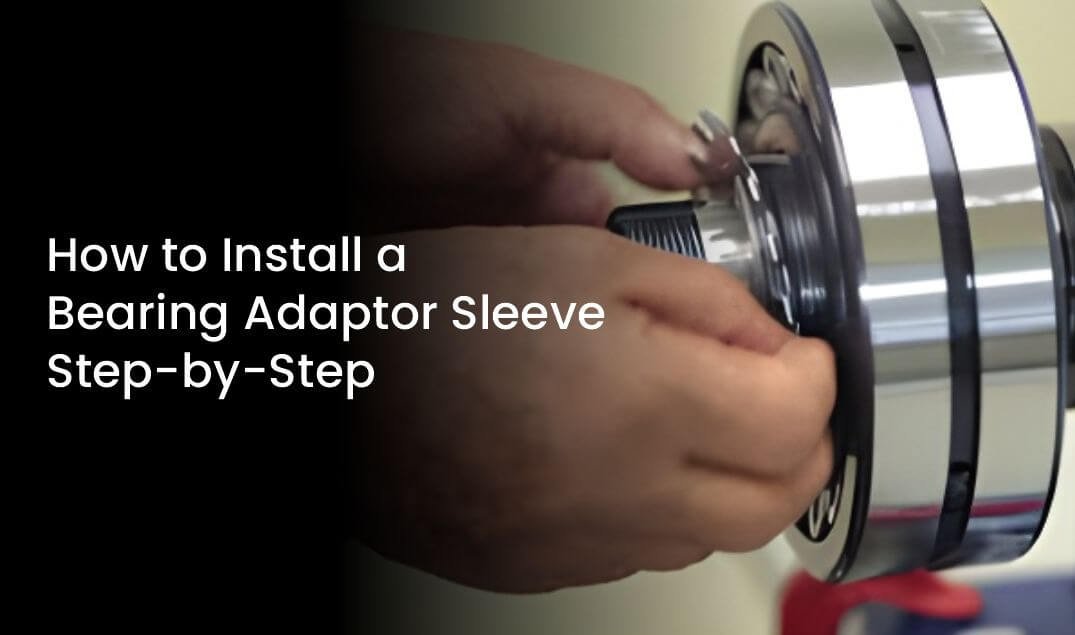
Installing a bearing adaptor sleeve is a critical process in many mechanical applications, particularly in industries like manufacturing, automotive, and heavy machinery. These sleeves are used to mount bearings with a tapered bore onto cylindrical shafts, ensuring a secure and precise fit. In India, where industrial growth is booming, understanding the correct installation process is essential for technicians, engineers, and DIY enthusiasts. This comprehensive guide will walk you through the step-by-step process of installing a bearing sleeve adapter, ensuring optimal performance and longevity of your equipment.
With a focus on clarity and precision, this blog will cover the tools required, preparation steps, and the installation process, along with tips to avoid common mistakes. Whether you’re a seasoned professional or a beginner, this guide will help you install adapter bearing sleeves with confidence.
What is a Bearing Adaptor Sleeve?
A bearing adaptor sleeve is a mechanical component designed to facilitate the mounting of bearings with a tapered bore onto a cylindrical shaft. It consists of a tapered sleeve, a lock nut, and a lock washer or clip. The sleeve allows the bearing to be securely fixed to the shaft without the need for complex machining, making it a cost-effective and efficient solution. Adapter sleeves are widely used in applications like pumps, fans, and conveyor systems, where precise alignment and secure mounting are crucial.
In India, adapter sleeves are popular due to their versatility and ease of use in various industrial setups. Understanding their function and installation process is key to ensuring smooth operation and preventing premature bearing failure.
Why Proper Installation Matters
Correct installation of a bearing sleeve adapter is vital to ensure the bearing operates efficiently and has a long service life. Improper installation can lead to misalignment, excessive vibration, or even bearing failure, resulting in costly repairs and downtime. By following a systematic approach, you can avoid these issues and maintain the reliability of your machinery.
This guide is tailored for Indian users, considering the local industrial environment and the need for practical, hands-on instructions. Let’s dive into the tools and materials you’ll need before starting the installation.
Tools and Materials Required
Before you begin, gather the following tools and materials to ensure a smooth installation process:
- Bearing adaptor sleeve kit: Includes the sleeve, lock nut, and lock washer or clip.
- Spanner wrench or hook spanner: For tightening the lock nut.
- Torque wrench: To apply the correct torque during installation.
- Cleaning rags and solvent: To clean the shaft and sleeve.
- Lubricant: Light machine oil or grease for smooth assembly.
- Dial indicator: For checking alignment and runout.
- Gloves and safety glasses: For personal protection.
- Soft mallet or hammer: For gentle tapping, if needed.
- Feeler gauges: To measure clearances, if required.
Having these tools ready will streamline the process and help you avoid interruptions. Always ensure your tools are in good condition to prevent damage to the bearing or sleeve.
Step-by-Step Installation Process
Step 1: Inspect and Prepare the Components
Before installing the bearing adaptor sleeve, inspect all components for damage or defects. Check the sleeve, bearing, lock nut, and lock washer for any signs of wear, corrosion, or manufacturing flaws. Ensure the shaft is clean, smooth, and free of burrs or nicks, as these can affect the fit.
Clean the shaft and sleeve thoroughly with a solvent and a lint-free rag to remove dirt, grease, or rust. A clean surface ensures proper contact and prevents slippage during operation. If the shaft has any imperfections, use fine sandpaper to smooth it out, but avoid excessive material removal.
Step 2: Lubricate the Components
Apply a thin layer of light machine oil or grease to the outer surface of the shaft and the inner surface of the adapter sleeve. This reduces friction during installation and helps the sleeve slide smoothly onto the shaft. Avoid over-lubricating, as excess oil can attract dirt and contaminate the bearing.
Lubrication is especially important in India’s humid climate, where corrosion can be a concern. Proper lubrication protects the components and ensures a secure fit.
Step 3: Position the Adaptor Sleeve
Slide the bearing adaptor sleeve onto the shaft, ensuring the tapered end faces the correct direction (usually toward the bearing). The sleeve should sit loosely on the shaft at this stage. If it’s difficult to slide, double-check for obstructions or improper cleaning.
Next, position the bearing onto the sleeve. The bearing’s tapered bore should align with the sleeve’s taper. Gently push the bearing until it makes contact with the sleeve, ensuring it’s seated properly.
Step 4: Install the Lock Nut and Washer
Place the lock washer (or clip) onto the sleeve, followed by the lock nut. Hand-tighten the lock nut until it contacts the bearing’s inner ring. At this stage, avoid over-tightening, as the final adjustment will be made later.
Ensure the lock washer’s tabs align with the slots on the sleeve. This will secure the nut in place once tightened.
Step 5: Tighten the Lock Nut
Using a spanner wrench or hook spanner, gradually tighten the lock nut to drive the bearing onto the sleeve’s taper. This process reduces the clearance between the bearing and the shaft, creating a tight fit. Tighten the nut slowly and check the bearing’s position frequently to avoid over-tightening.
If specified by the bearing manufacturer, use a torque wrench to apply the recommended torque value. This ensures the bearing is neither too loose nor overly stressed, which could lead to premature wear.
Step 6: Secure the Lock Nut
Once the bearing is properly seated, secure the lock nut by bending one of the lock washer’s tabs into a slot on the nut. This prevents the nut from loosening during operation. If your sleeve uses a lock clip instead, ensure it’s properly engaged.
Step 7: Check Alignment and Runout
After securing the bearing, use a dial indicator to check the shaft’s alignment and runout. Rotate the shaft slowly and observe the indicator to ensure there’s no excessive wobble or misalignment. If you detect any issues, loosen the lock nut, reposition the bearing, and repeat the tightening process.
Proper alignment is critical to prevent vibration and ensure smooth operation, especially in high-speed applications common in Indian industries.
Step 8: Final Inspection and Testing
Perform a final inspection to ensure all components are secure and properly aligned. Check that the bearing rotates smoothly without unusual noise or resistance. If everything is in order, the installation is complete.
Test the machinery under low load to confirm the bearing operates correctly. Monitor for any signs of overheating, vibration, or noise, which could indicate an installation error.
Common Mistakes to Avoid
- Over-tightening the lock nut: This can damage the bearing or sleeve, reducing service life.
- Poor cleaning: Dirt or debris on the shaft or sleeve can cause misalignment or slippage.
- Incorrect alignment: Failing to check alignment can lead to vibration and premature failure.
- Using damaged components: Always inspect parts for defects before installation.
- Skipping lubrication: Inadequate lubrication can make installation difficult and increase wear.
By avoiding these mistakes, you can ensure a successful installation and reliable performance from your adapter bearing sleeves.
Maintenance Tips for Longevity
To maximize the lifespan of your bearing and sleeve, follow these maintenance tips:
- Regular inspections: Check for signs of wear, corrosion, or looseness periodically.
- Lubrication: Reapply lubricant as needed, following the bearing manufacturer’s guidelines.
- Monitor operating conditions: Keep an eye on temperature, vibration, and noise levels.
- Clean environment: Keep the surrounding area free of dust and debris to prevent contamination.
In India’s diverse industrial settings, regular maintenance is key to preventing unexpected downtime and costly repairs.
Conclusion
Installing a bearing adaptor sleeve is a straightforward process when done correctly, but it requires attention to detail and the right tools. By following this step-by-step guide, you can ensure a secure and precise fit, enhancing the performance and longevity of your machinery. Whether you’re working in a factory, workshop, or garage in India, mastering this process will save time and resources while keeping your equipment running smoothly.
For any further questions or specific applications, consult the bearing manufacturer’s guidelines or seek advice from a professional technician. With practice, installing adapter sleeves will become second nature, ensuring your bearings perform at their best.

